 |
 |
|
Gassaway
|
 |
|
Dundon
|
 |
Ansted
Gauley Bridge
Glen Jean
Mt. Hope
Thurmond |
 |
|
Alum Creek
Branchland
|
 |
|
Logan
|
 |
|
Davy
Iaeger
Kimball
Roderick
Twin Branch
War
Welch
|
 |
|
Historic Matewan
Williamson
Dingess
Red Jacket
|
 |
|
Itmann
Mullens
Oceana
Sabine
Wyco
Wyoming
|
|
|
|
|
|
|
|
|
|
|
|
|
|
HISTORY
|
| MULLENS
A historic railroad town in Wyoming County, West Virginia. Mullens was incorporated in 1912. Located on the Guyandotte River, the town developed rapidly during the early 1900s when the mainline of the Virginian Railway (VGN) located their marshalling yard/terminal in this community in 1906. Two years later, the first commercial coal mine in the county opened in Mullens and the community became the center of the smokeless coal field.
During the 1920s, Mullens had a bank, weekly newspaper, theater, hospital, five churches, high school, two elementary schools, three miles of paved streets and a population of about 5,000. As of the 2000 census, Mullens population was 1,769.
|
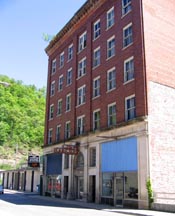 |
|
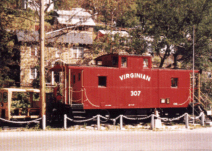 |
Be sure to stop by the Virginian Railway Company Caboose #307.
Built in 1949, Caboose #307 has been restored and now serves as both a railroad and area museum. #307 was originally used in the Elmore train yard in Mullens and sits on original ties and rails. Click here for more. |
|
|
In 2001, a flood nearly destroyed the town. At that time, there were 75 structures of historic significance noted. Fifteen of the historic buildings, all built in the 1920s, are noted below.
- Webster Apartments - originally Mullens General Hospital, 1921.
- Wyoming Hotel - built in 1918, destroyed by fire and rebuit around 1922.
- Eatwell Cafe - built in 1922. Closed after the 2001 flood.
- Smiley Department Store - 1921-22
- Trent Building - 1922, 3-story brick building. Has housed banks, clothing store and currently has been made into apartments.
- G.C. Murphy Company Building - 1944, now houses Southern Highlands Inc., a mental health organization.
- Markowitz Building - 1922, "Army & Navy Store" - men's clothing. Owned by the Markowitz family, the only Jewish family to live in the area for any extended period of time.
- The Law Building - 1923, once housed an African-American hotel and restaurant.
- Mullens Dollar Store - 1924, dry goods, clothing, notions
- Hatcher Building - 1922, furniture store, SEARS Catalog Store and bank.
- Levi Lusk Apartment and Garage Building - 1929, housed the Craft Bus Line as a service garage.
- Ball & Shannon Building - 1927, general merchandise, grocery, school supplies, school books
- A.J. Mullens Building - 1921, store and real estate office with apartment on second floor. Also housed the Mullens Motor County (automobiles) for nearly 40 years.
- The former Mullens Grade School has been converted into the Mullens Opportunity Center that focuses on improving education, economic conditions, environmental quality, historical preservation and facilities for social and recreational use.
|
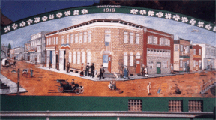 |
Don't miss the Murals!
Several large murals have been painted on a few of the buildings on Howard Avenue and at the fire station depicting days gone by. The Virginian Mural is 20 x 90 feet and pictures of an old Virginian Railway steam engine #215, pulling baggage car #53, the Mail Car and a passenger coach through a free standing, upsupported tunnel in west Mullens. Click here for information/photos. |
|
Another interesting feature is Stone Tunnel, a freestanding, unsupported railroad tunnel cut through solid rock in 1906 by the Virginian Railway Company. Still stands today! |
|
|
| ITMANN
Itmann is an unincorporated former mining town located between Pineville and Mullens. The Itmann mine was opened in 1918 by the mighty Pocahontas Fuel Company (CONSOL). It was named after the president of the company, Issac T. Mann or I.T. Mann which was eventually shortened down to Itmann. The company built 120 buildings for its employees and their families. During the 1950s and 60s, it was the most productive mine in West Virginia.
|
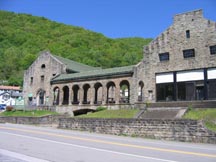 |
|
|
There is no formal interpretation of the rail/coal resources in Itmann. This is what one can see today.
By the 1980s, Island Creek Coal Company was mining in Pocahontas No. 3 at Itmann, employing around 500 miners. Eventually, the mine was closed, but the company store is still standing and is a registered historical landmark in West Virginia. Many of the original houses still remain. The 1917, 2-room schoolhouse is preserved. And one can still see the 324 feet high steel bridge which served as a mine car trestle built in 1919 for WWI and the Itmann Coal Tipple - Coal prep plant built in 1948 by Pocahontas Consolidated Coal Company. Itmann is still an active community and has a welding shop that fabricates escalators for mines.
|
|
| MABEN
The Town of Maben was the home of Ritter Lumber Company from 1903 to 1948 which became the world's largest hardwood lumber producer in 1929. Maben changed to a mining town from 1944 - 1969 with the opening of the Mabel Coal Mine. Eighteen remodeled lumberjack dwellings and one original dwelling remain, along with a log one-room schoolhouse built in 1936.
There is no formal interpretation of the rail/coal resources in Maben.
|
|
| PINEVILLE
Town settled in 1840. By the late-1920s, Pineville had a bank, weekly newspaper, three churches, courthouse, school building and the city maintained a small park and bathing beach.
|
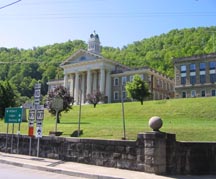 |
|
|
There is no formal interpretation of the rail/coal resources in Pineville.
One can still see the Courthouse built in 1916 and County Jail in 1929 from native stone quarried nearby. Population is 715 (2000 census)
|
|
| Town of Otsego - Coal mining town from 1917 - 1968. Virginia Railway Tunnel built there in 1926. Otsego on Cedar Creek - strip and underground coal mine. |
| Town of Nuriva - coal mine town, 1916. |
| Towns of Tralee, Alpoca and Bud - original 1914 dwellings, remodeled and privately owned. Alpoca has an Opera House. Large superintendent house remains. |
| Town of Sabine - coal mining plant now idle. Original houses and store buildings still in existence from 1924. |
| Town of Wyoming - coal mining town, est. 1938. Childhood home of Curt Warner, pro football player. |
|
|
| For an inventory of all the tourism related offerings in Wyoming County West Virginia, click here. |
|
Wyoming County is part of the NCHA*, an 11 county initiative* in West Virginia“...to preserve, protect, and interpret lands, structures, and communities with unique and significant historic and cultural value associated with the coal mining heritage of West Virginia.” The counties of Boone, Cabell, Fayette, Logan, McDowell, Mercer, Mingo, Raleigh, Summers, Wayne, and Wyoming are participants in this initiative. Go to http://www.coalheritage.org/ for more information.
*The National Coal Heritage Area (NCHA) is one of only 22 nationally designated heritage areas in the entire United States.
|
|
WYOMING CHAMBER OF COMMERCE
P.O. Box 235, Mullens WV 25882
|
|

